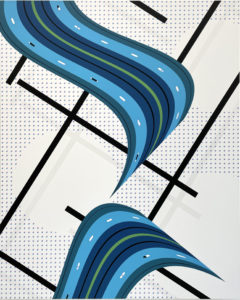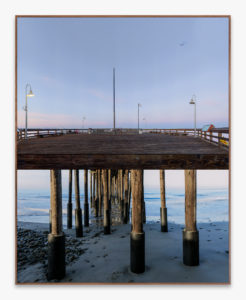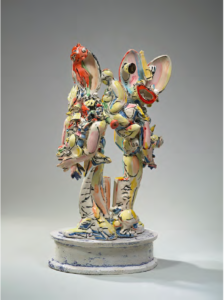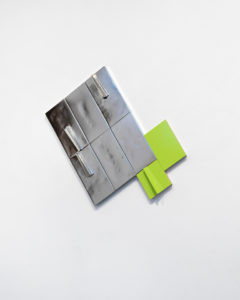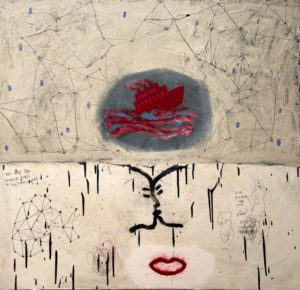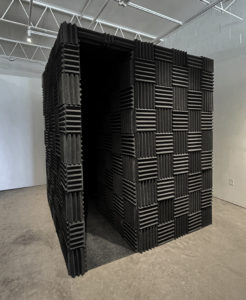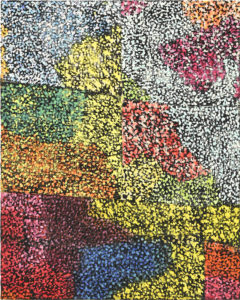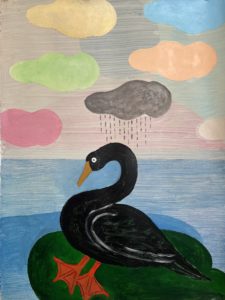September 18, 2023—December 21, 2023 | Reception Saturday Oct 21, 4-6PM
After 24 years in Seattle, James Harris Gallery will inaugurate our new home in Dallas with a group exhibition titled “Moment Momentum.” The word “moment” is associated with the element of time whereas “momentum” includes the qualities of time as well as motion. Taken together, the artworks on view, draw connections with the nature of time, the transferring aspect of memory, and the immense pleasure in the details of looking at objects. The show will also use the conceptual framework of time and motion. Works will be moved and added over the course of the first three weeks culminating in the final installation on Saturday, October 21. “Moment Momentum” includes the work of Squeak Carnwath, Viola Frey, Gary Hill, Fay Jones, Cameron Martin, Evan Nesbit, Richard Rezac, Akio Takamori, Bing Wright and Amir Zaki. All artists the gallery has worked with over the years.
Gary Hill
Gary Hill is a pioneering artist of new media and video work. His video works incorporate commentaries on society and culture as well as bringing in poetic themes and ideas. Hill considers video as a medium to be the most receptive, flexible, and far-reaching mirror of consciousness. He creates psychological spaces within his artworks that allow viewers to see this mirror of their own consciousness.
Gary Hill lives and works in Seattle, WA. Exhibitions of his work have been presented at museums and institutions worldwide, including solo exhibitions at the Fondation Cartier pour l’art contemporain, Paris; San Francisco Museum of Modern Art; Centre Georges Pompidou, Paris; Guggenheim Museum SoHo, New York; Museum für Gegenwartskunst, Basel; Museu d’Art Contemporani, Barcelona; and Kunstmuseum Wolfsburg, among others. Commissioned projects include works for the Science Museum in London and the Seattle Central Public Library in Seattle, Washington, and an installation and performance work for the Coliseum and Temple of Venus and Rome in Italy. Hill has received fellowships from the National Endowment for the Arts and the Rockefeller and Guggenheim Foundations, and has been the recipient of numerous awards and honors, most notably the Leone d’Oro Prize for Sculpture at the Venice Biennale (1995), a John D. and Catherine T. MacArthur Foundation Fellowship Award (1998), the Kurt-Schwitters-Preis (2000), and honorary doctorates from The Academy of Fine Arts Poznan, Poland (2005) and Cornish College of the Arts, Seattle, WA (2011).
Fay Jones
Fay Jones’ work conveys the intimacy of mind, emotion, and spirituality. As a whole, Jones’ paintings echo a tremendous sense of humanity. The pieces meld figures, animals and symbols to conjure up existential meaning of human experience. Her characters become signifiers, representing the watery depth of the unconscious.
Fay Jones received a BFA from the Rhode Island School of Design in 1957. Awards she has received include the Joan Mitchell Painters and Sculptors grant in 2013, the Seattle Art Museum’s 2006 Poncho Artist of the Year award, grants from the NEA in 1983 and 1990, the Washington State Arts Commission in 1984, and La Napoli Art Foundation in 1989. Her work has been extensively collected in the Northwest, and is included in the collections of the Portland Art Museum and the Hallie Ford Museum of Art in Oregon, and the Seattle Art Museum and the Tacoma Art Museum in Washington, as well as the Cities of Seattle and Portland. Major exhibitions include a 2007 retrospective at the Hallie Ford Museum of Art at Willamette University, a 1997 traveling retrospective with the Boise Art Museum, and exhibitions at the Portland Art Museum, the Seattle Art Museum, the Museum of Northwest Art in La Conner, WA, the Anchorage Museum of History and Art, and the Palm Springs Desert Museum in California.
Evan Nesbit
Evan Nesbit's primary focus iss spatial abstraction where his burlap canvases were meticulously crafted through a process of dying, sewing and extrusion of acrylic paint pressed through the weave of the material. By dying the support structure and driving the pigment medium through it, the artist seamlessly integrated the medium with the support, creating an aesthetic teleology of flatness and pictorial organization. Nesbit continues his use of pushing pigment through the reverse side of the substrate, and now photographic images have been introduced by printing on a vinyl matrix. His markings compliment and disrupt the physical traces of reproduced photograph, trapping the image between the mechanical and the painted gesture. Nesbit’s new paintings allude to the inevitable commodification of the digital image but through his use of highly saturated color and neon tones of paint, the works situate themselves between the historical and contemporary painting antecedents in which artists incorporated found or mechanically produced images.
Evan Nesbit (b. 1985) lives and works in Grass Valley, CA. Nesbit received his BFA from San Francisco Art Institute in 2009 and his MFA from Yale University in 2012. He has been awarded the Yale University Ely Harwood Schless Memorial Fund Prize for painting. Other recent solo exhibitions include: Van Doren Waxter, New York, Annarumma Gallery, Naples, Italy (2017); Koki Arts, Tokyo, Japan, Roberts and Tilton, Los Angeles, CA, 11R, New York, NY(2016. His work has additionally been included in numerous group exhibitions, such as: Sargent’s Daughter, New York NY (2017) 88 Projects Berlin, Germany Praz-Delavallade, Paris, France (2015).
Cameron Martin
Cameron Martin is a contemporary painter whose work over the years has varied from landscape paintings to more recent abstract works focusing on color, shape, and space. Much of Martin’s work in the past has played with notions of site and non-site, with the image serving as a marker for unattainable direct experience. In this new work, it is as if Martin has revealed the originary site. No longer insisting on the muted tones characteristic of his earlier work, which elicited a contemplative silence, there is a sense of optimism in the commanding presence of these new pictures, a timeless physicality that has the potential to endure.
Cameron Martin was born in Seattle, Washington in 1970 and lives and works in Brooklyn, NY. He was educated at Brown University and the Whitney Independent Study Program. He is the recipient of a 2010 John Simon Guggenheim Memorial Foundation Fellowship and a 2008 Joan Mitchell Foundation Fellowship. Solo exhibitions include ”Bracket”, Greenberg Van Doren Gallery, NY (2011), “Currents 97”, St. Louis Museum of Art, St. Louis, MO (2006), and “Focus 3”, Philbrook Museum of Art, Tulsa, OK (2006). Martin was included in the prestigious Whitney Biennial in 2004. His works are included in the collections of the Albright-Knox Art Gallery, the Saint Louis Art Museum, the Seattle Art Museum and the Whitney Museum of Art, among others. In June of 2017, the Museum at SUNY Albany hosted a full-scale exhibition of his abstract work, accompanied by a catalogue including an essay by art historian and critic Suzanne Hudson.
Squeak Carnwath
Squeak Carnwath is a painter and printmaker who uses text, color field painting, and a wide variety of recognizable symbols to make interesting, engaging, and relatable works. Her works have the intimate feel of a diary, but acknowledge universal themes that are familiar to every viewer. Her paintings work together to form a kind of visual conversation within the spaces that they are displayed. Carnwath utilizes traditional painting techniques such as trompe l’oeil and symbolism, while also making statements that question the viewer’s thoughts and emotions. Carnwath wants the viewer to make connections between words, objects and shapes; connections that often evoke moments of humor and sadness. Carnwath currently lives and works in Oakland, California.
She has received numerous awards including the Society for the Encouragement of Contemporary Art (SECA) Award from San Francisco Museum of Modern Art, two Individual Artist Fellowships from the National Endowment for the Arts, a Guggenheim Fellowship and the Award for Individual Artists from the Flintridge Foundation. Carnwath is Professor Emerita at the University of California, Berkeley.
Amir Zaki
A firm believer in the transformative power of the photographic image, Zaki images are rooted in the history of the medium and uses it to shed light on the means of representation. Over the last 16 years, Zaki has pushed the physicality of the photograph’s two dimensional construct, allowing it to exist on its own and also exploring its own object-ness. In order to capture and record the original site, Zaki’s representations depict the complexity of place in terms of interactive evolving experience, an ongoing ecological intervention. The artist responds to the shifting contemporary landscape where nothing is permanent, constructing his own visual language to illustrate an entire mythology of place.
Amir Zaki lives and works in Southern California. He received his MFA from UCLA in 1999 and has been exhibiting nationally and internationally since graduating. He is a full professor at the University of California at Riverside. His work is included in many museum collections including the Hammer Museum of Art, Los Angeles County Museum of Art, New Museum of Contemporary Art, Orange County Museum of Art, Santa Barbara Museum of Art, and the Whitney Museum of American Art, among others.
Akio Takamori
Takamori was a seminal figure in ceramic art, whose work over the past thirty years has left an enduring impact on the Pacific Northwest arts and the medium itself. His work is often autobiographical, drawing on his life in Japan, his family, and mythological themes. He is known for his coil-built figurative sculptures in which the narrative painting defines the form. Takamori explored themes of cultural identity by engaging the history of Eastern and Western aesthetics. Bold form and color defines his body of work, which is highly expressive of human emotion and sensuality.
Akio Takamori was born and raised in Japan. He has been exhibiting in the United States, Europe and Asia since the mid 1980s. Takamori received his BFA from the Kansas City Art Institute in 1976 and his MFA from the New York State College of Ceramics, Alfred University in 1978.
Takamori’s work is included in numerous collections including the Nelson-Atkins Museum of Art in Kansas City, Los Angels County Museum of Art, Victoria & Albert Museum in London, Ariana Museum in Geneva, the Seattle Art Museum, and the Museum of Arts and Design in New York City. He is the recipient of numerous awards, including three National Endowment for the Arts Visual Artists Fellowship Grants (1986, 1988, 1992), the Joan Mitchell Foundation Painters and Sculptors Grant (2006), and the USA Ford Fellowship (2011). Takamori was a professor of art at the University of Washington. He lived and worked in Seattle.
Bing Wright
Wright has always been fascinated by the correlation between the photo and a mirror, both being silver based picture planes. At the beginning of his artistic career, Wright was exposed to the potential of the medium by John Szarkowski’s legendary exhibition Mirror and Windows in 1978, which reconstructed the framework of the photographic image as a two-dimensional pictorial surface into a conceptual space. With a postmodern perspective of the photographic image, the medium expanded into diverse practices that continue to reorient our relationship to photography.
Bing Wright was born in Seattle in 1958 and received a Bachelor of Arts in Art History from Columbia University, New York. His work been shown in exhibitions at the New Museum, New York; White Columns, New York; the Queens Museum of Art, New York; and the Tang Museum and Art Gallery, Saratoga Springs, among others. His work is in several public collections, including The Museum of Modern Art, the Portland Art Museum, the Seattle Art Museum, Goldman Sachs, JP Morgan Chase Bank, and Citigroup. Wright recently curated an exhibition of 1970s photography from the collection of the Washington Art Consortium. He lives and works in New York City.
Richard Rezac
Richard Rezac (b. 1952, Nebraska) creates refined, and elegant objects comprised of pure reductive forms; his inspiration drawn in part from emotive encounters with architectural and design details situates his work closely to the Post-minimalist artists of the 1980s. Human in scale and mounted on the wall, suspended from the ceiling, or placed on the floor, Rezac’s sculptures open viewers to close-looking and reflection upon the forms. Surfaces of painted and natural wood, aluminum and bronze contain subtleties that reveal the pristine sculptures as actually handmade. Richard Rezac has received prestigious awards including the John Simon Guggenheim Memorial Foundation Fellowship, the Joan Mitchell Foundation Award, Louis Comfort Tiffany Foundation Award, and the Rome Prize Fellowship from the American Academy in Rome. He has exhibited at the Art Institute of Chicago, Museum of Contemporary Art- Chicago, Yale University Art Gallery, Aspen Art Museum, Portland Art Museum and others. Public collections include the Art Institute of Chicago, Dallas Museum of Art, Portland Art Museum, Detroit Institute of Art, and the Smart Museum at the University of Chicago, among others. Rezac lives and works in Chicago, IL where he is Adjunct Professor of Sculpture, Drawing, and Graduate Advising at The School of the Art Institute of Chicago (SAIC).
(copied from Rhona Hoffman)
Viola Frey
Many people think of Viola Frey as a maker of ceramic objects. Formerly trained as a painter, she studied with both Richard Diebenkorn and Mark Rothko, Frey’s practice incorporated painting, drawing and even photography. Frey was a cultural observer and her work reflected how she interpreted the world. One core theme explored throughout her career was the social commentary on the power structure between male and female and the roles they played during her lifetime. This investigation is prescient today with the continued struggle for equal rights and the upward path to break the glass ceiling. Her work was strongly influenced by her passion for art history, and her resulting imagery can often be viewed through this lens.
Framed Archival Photograph
30" x 25"
Edition of 2 and 2APs
Inquire about this work
Ceramic and Glazes
43" x 17" x 22"
© Artists’ Legacy Foundation/Licensed by ARS, New York
Inquire about this work
Nickel-plated bronze and painted maple wood
21" x 22" x 1"
Inquire about this work
Oil and Alkyd on canvas over panel
36" x 36"
Inquire about this work
Wood and/or metal construction, acoustic paneling, simple straight-back chair, 7” HD industrial flat panel display, microphone stand, headphones, media player with activation switch, HD video (color, stereo sound, 3:10 min), and assorted cabling
6’5” x 7”8” x 8’
Edition of 2 and AP
Inquire about this work
Media Installation
103 x 96 x 83 inches
Edition of 2 + AP
Inquire about this work
Inkjet prints with aluminum leaf, diptych
Each 52” x 41 ½” x 2” framed Overall 52” x 87”
Unique
Inquire about this work
Acrylic and collage on paper
30" x 22 1/2"

